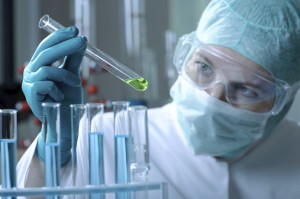Whenever your doctor takes a specimen during an exam (such as blood, urine or a throat culture), you are actually being treated by two doctors. The second is a pathologist, who is an expert in diagnostic medicine.
You’re probably familiar with the “Intel Inside” ad campaign, which reminds viewers or readers that the company’s microchips are powering their computers. A pathologist is like the “Doctor Inside” for medicine. It’s been estimated that about 70 percent of medical decisions involve lab testing by pathologists.
 Pathologists run the laboratories that examine your blood cells to determine if your cholesterol is too high or to identify the microorganism causing your infection. They also test the sensitivity of the infecting bacteria to different antibiotics and report their findings to your doctor, who can then prescribe the antibiotic that will be most effective in killing the bacteria.
Pathologists run the laboratories that examine your blood cells to determine if your cholesterol is too high or to identify the microorganism causing your infection. They also test the sensitivity of the infecting bacteria to different antibiotics and report their findings to your doctor, who can then prescribe the antibiotic that will be most effective in killing the bacteria.
Have you ever donated blood or had a blood transfusion? Pathologists oversee blood banks, practice transfusion medicine and ensure that the blood supply is safe and used appropriately.
You more than likely know someone who has had a biopsy, or perhaps have had one yourself. Have you ever wondered how the tissues are diagnosed? Or why it can sometimes take several days before your doctor can share the results? As with blood, the tissue from a biopsy is sent to a special pathology laboratory, where it takes approximately one day to prepare the biopsy specimen by embedding it in paraffin (wax). Specially trained technologists cut thin sections of the paraffin-embedded biopsy, put these sections on glass slides and stain them with special dyes.
The slides are then viewed by a pathologist with the expert knowledge to determine whether the biopsy tissue is normal or abnormal (injured, inflamed or cancerous). The pathologist can usually give your physician a diagnosis and report in two to three days. Sometimes the biopsy is especially complicated or the results are ambiguous. When this happens, it may be necessary to do more stains or have the slides reviewed and interpreted by pathologists with special expertise, which can delay the report by several days.
It would be a mistake to think that pathologists just read slides and write reports. Your physician most likely has often turned to pathologists for advice on testing or treatment. Pathologists also are expert at characterizing the process of diseases, and can help guide the medical management of a patient in ways that have a profound effect on the patient’s life. In labs and hospitals, these pathologists ensure that the collection and analysis of all specimens follow strict measures of quality control to ensure accurate diagnoses.
You might say that even though pathologists work behind the scenes, they’re front and center when it comes to making certain you and other patients get the best treatment.
What would you like to know about pathology? Share your questions here.


Comments on this entry are closed.
How much contact do pathologists have with patients, if any?
Hi Alexa,
Usually there is no to minimal contact between the pathologist and the patient. Pathologists do perform certain procedures such as fine needle aspirations (e.g. for thyroid or breast cancer) or apheresis to remove pathologic cells or proteins from the blood. In those situations there would be direct contact between the patient and pathologist.
Regarding the interpretation of a laboratory test or a biopsy, the pathologist interacts with the primary care physician. On rare occasions in our institution a pathologist may discuss a result with a patient. This may be different in a small community hospital where a pathologist may have more interaction.